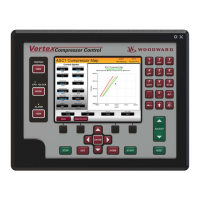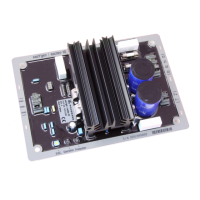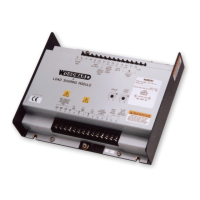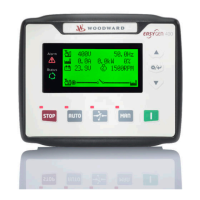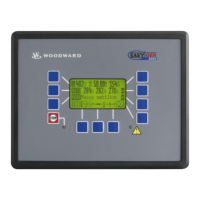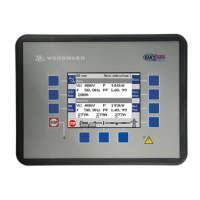Manual 37128A GCP-20 Series - Genset Control
Page 58/190 © Woodward
Internally Detected Alarms
List of alarms determined internally depending on the variables which are monitored:
Type of alarm Alarm
class
Alarm text Relay output
(terminal)
Generator overspeed F3
Over speed
Generator overfrequency F3
over freq.
Generator underfrequency F3
low freque.
Generator overvoltage F3
G-Overvolt.
Generator undervoltage F3
G-.underv.
Generator overcurrent, step 1 F3
Gen.curr. 1
Generator overcurrent, step 2 F3
Gen.curr. 2
Reverse/reduced load F3
power fail
Monitoring of load unbalance F3
asymme.load
Overload (GCB is imm. opened, but with coasting) F2
G-Overload
Mains overvoltage F0
M-Overvolt.
Mains undervoltage F0
M-Undervolt
Mains overfrequency F0
M-Overfreq.
Mains underfrequency F0
M-Underfrq.
Mains phase shift F0
Phase shift
Battery undervoltage F1
Bat.undervo
GCB synchronization time monitoring F1
GCB syn.fai
MCB synchronization time monitoring F1
MCB syn.fai
Time monitoring of the GCB add-on F1
GCB failure
Time monitoring of the MCB add-on F1
MCB failure
Mechanical malfunction GCB F1
GCB failure
Mechanical malfunction MCB F1
MCB failure
Alarm reference power zero control with interchange
synchronization on GCB
F1
power zero
Maintenance call F1
Service
Interface monitoring X1..X5 F1
fault X1X5
Interface monitoring Y1..Y5 F1
fault Y1Y5
Plausibility control pickup/generator monitoring F3
Pickup/fre.
Shutoff malfunction F3
stop fail
Start failure F3
Startfail
Centralized
alarm via relay
manager with
parameter 85
Table 7-5: Internal alarms
NOTE
In the event of mains alarms, the GCB or the MCB is opened according to the setting, and is closed
again following the mains settling time.
Alarm Acknowledgement
DANGER
The unit may start unintentionally if an alarm, which caused the unit to shut down, is acknowledged
and a release is still present. Before acknowledging the alarm, check the cause of the alarm, in order to
protect operating personnel located in the vicinity of the system against injuries, and to protect the mo-
tor against unintentional destruction.
⇒ In the event of an alarm whose cause is not or not clearly detectable, NEVER press the acknowl-
edgement button! The destruction of the motor cannot otherwise be ruled out !
By pressing the button "QUIT" the output of the centralized alarm and the alarm messages are acknowledged on
the LC display according to the following logic :
NOTE
In order to acknowledge alarm messages via terminal 6, the "Acknowledgment" function must be as-
signed to this terminal.
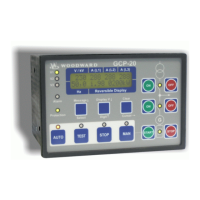
